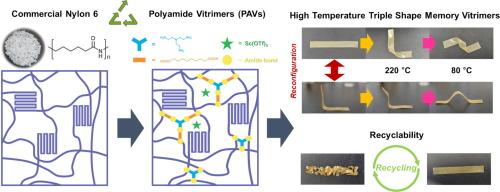可重构和可回收的高温三重形状记忆聚合物从商业尼龙6玻璃体升级回收
IF 13.2
1区 工程技术
Q1 ENGINEERING, CHEMICAL
引用次数: 0
摘要
本研究介绍了一种具有三重形状记忆性能的高温形状记忆聚合物(HTSMPs)的开发,该聚合物是通过商用尼龙6的玻璃化反应获得的。这些材料表现出卓越的可再加工性、可重构性和可回收性。以三(2-氨基乙基)胺(TAA)和己二酸(SA)为交联盐,三酸钪(Sc(OTf)3)为催化剂,采用固态聚合(SSP)法制备了聚酰胺玻璃体(PAV)。通过改变交联剂和催化剂的浓度,系统地调整了pav的热性能和粘弹性。其中,PAV-5/1(分别含有5和1 mol%的交联剂盐和催化剂)表现出优异的热稳定性,并在多次再加工循环后保持了接近原始的拉伸强度和模量,显示出良好的机械再加工性能。动态力学分析表明,该材料具有较高的形状固定性和恢复率,在恶劣的高温条件下具有一致的三重形状记忆行为。通过转酰胺反应重塑PAV-5/1的永久结构,证明了PAV-5/1的可重构性,通过成功地从粉末中再加工薄膜,验证了PAV-5/1的可回收性。这些发现突出了PAV-5/1作为一种多功能HTSMP的潜力,可用于航空航天结构和高温致动器等先进应用,同时通过聚合物升级回收为可持续发展做出贡献。本文章由计算机程序翻译,如有差异,请以英文原文为准。

Reconfigurable and recyclable High-Temperature triple shape memory polymers from upcycling of commercial Nylon 6 vitrimers
This study introduces the development of high-temperature shape memory polymers (HTSMPs) with triple shape memory properties, achieved through the vitrimerization of commercial Nylon 6. These materials exhibit exceptional reprocessability, reconfigurability, and recyclability. Polyamide vitrimer (PAV) was synthesized via solid-state polymerization (SSP) using tris(2-aminoethyl)amine (TAA) and sebacic acid (SA) as the crosslinker salt, with scandium(III) triflate (Sc(OTf)3) serving as the catalyst to facilitate dynamic covalent bond exchange. The thermal and viscoelastic properties of the PAVs were systematically tuned by varying the crosslinker and catalyst concentrations. Among the formulations, PAV-5/1 (containing 5 and 1 mol% crosslinker salt and catalyst, respectively) exhibited excellent thermal stability and retained nearly its original tensile strength and modulus after multiple reprocessing cycles, demonstrating its robust mechanical reprocessability. Dynamic mechanical analysis (DMA) revealed high shape fixity and recovery ratios, with consistent triple shape memory behavior under harsh high-temperature conditions. The reconfigurability of PAV-5/1 was demonstrated through reshaping its permanent structure via transamidation reactions, while its recyclability was validated by successfully reprocessing films from powder. These findings highlight the potential of PAV-5/1 as a multifunctional HTSMP for advanced applications, such as aerospace structures and high-temperature actuators, while contributing to sustainability efforts through polymer upcycling.
求助全文
通过发布文献求助,成功后即可免费获取论文全文。
去求助
来源期刊

Chemical Engineering Journal
工程技术-工程:化工
CiteScore
21.70
自引率
9.30%
发文量
6781
审稿时长
2.4 months
期刊介绍:
The Chemical Engineering Journal is an international research journal that invites contributions of original and novel fundamental research. It aims to provide an international platform for presenting original fundamental research, interpretative reviews, and discussions on new developments in chemical engineering. The journal welcomes papers that describe novel theory and its practical application, as well as those that demonstrate the transfer of techniques from other disciplines. It also welcomes reports on carefully conducted experimental work that is soundly interpreted. The main focus of the journal is on original and rigorous research results that have broad significance. The Catalysis section within the Chemical Engineering Journal focuses specifically on Experimental and Theoretical studies in the fields of heterogeneous catalysis, molecular catalysis, and biocatalysis. These studies have industrial impact on various sectors such as chemicals, energy, materials, foods, healthcare, and environmental protection.
 求助内容:
求助内容: 应助结果提醒方式:
应助结果提醒方式:


